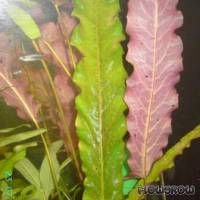



Barclaya longifolia, which belongs to the Nymphaceae family, is found in large parts of Southeast Asia. However, this plant does not form any floating leaves even though it is technically spoken a water lily. Its elongated, reddish to green, wavy leaves make it look like a Cryptocoryne at first glance, at least as long as the plant is still young. However, the plant soon grows to a size comparable to a large Echinodorus. There is a red and a green variety, the latter with a reddish leaf underside. The green variety grows a little larger than the red one.
Like other Nymphaeaceae, Barclaya longifolia can be kept small for a longer time when its roots are restricted, e.g. by planting into a small pot. In general, this Barclaya is a relatively undemanding plant as long as it gets sufficient light and warm water (not under 24 °C). Normally, it absorbs sufficient nutrients from the water, but a substrate fertiliser is of advantage. Keep in mind that root-fed Barclaya longifolia tend to grow even larger.
Though not susceptible to nutrient deficiencies, this plant is a snail magnet. Even in tanks where snails are per se unproblematic, the leaves of Barclaya longifolia may be strewn with holes. Thus, be prepared to do something against snails, as the plant's leaves are very tender and easily damaged. Barclaya longifolia may withdraw from time to time. During these resting phases, all the leaves die back. The rhizome rests for a few weeks, sprouting new leaves afterwards.
Propagation is as interesting as the plant itself. In general, new plants may form on the underside of the tuber of larger plants, however, it is far more productive to undertake sexual propagation. Barclaya longifolia is among the easiest plants regarding propagation through seed. Healthy plants form flower stalks regularly, which look a bit like those of poppies. When they reach the water surface, the flower opens and, in doing so, pollinates itself. As soon as the seeds start to develop, the thicker part of the flower increases in size even more, and when the seeds are mature, it dissolves. As soon as the plant has reached this stage, it is recommendable to remove the flower stalk with the flower. Inside the pod, there is a whiteish, jellylike substance enclosing many thorny, brownish seeds. If you don't remove the pod, the seeds will spread in the entire aquarium, which you want to avoid. Wash off the jellylike substance of the seeds and sow them in sandy ground in a calm tank with direct light. If you plan to have fish in there, make sure they are sedate and do not dig. Another promising approach is to plant the seeds in sandy substrate on a dish outside the tank. You can even spread the seeds in the well-lit foreground of a planted aquarium. Over the months, a sufficient number of young plants will form. Sprouting seeds are especially susceptible to snail damage! When they reach 6 to 10 cm in height, they can be replanted to their final position in the aquarium.
Barclaya longifolia needs lots of room to display its beauty. Thus, aquarium starting at 250 litres upwards are recommendable.
Comparable to some large Echinodorus, it is not easy to find suitable plants for grouping around a B. longifolia.
It can be used as beautiful solitary plant in the background or on the side of an aquarium. For example, it is ideally suited for a discus tank, where it can enjoy the warmth and "feel at home".
<a href="https://www.flowgrow.de/db/aquaticplants/barclaya-longifolia" target="_blank"><img alt="Barclaya longifolia" title="Barclaya longifolia" src="https://www.flowgrow.de/db/widget/aquaticplants/barclaya-longifolia" /></a>
[url=https://www.flowgrow.de/db/aquaticplants/barclaya-longifolia][img]https://www.flowgrow.de/db/widget/aquaticplants/barclaya-longifolia[/img][/url]
[widget=aquaticplants/barclaya-longifolia]Barclaya longifolia[/widget]